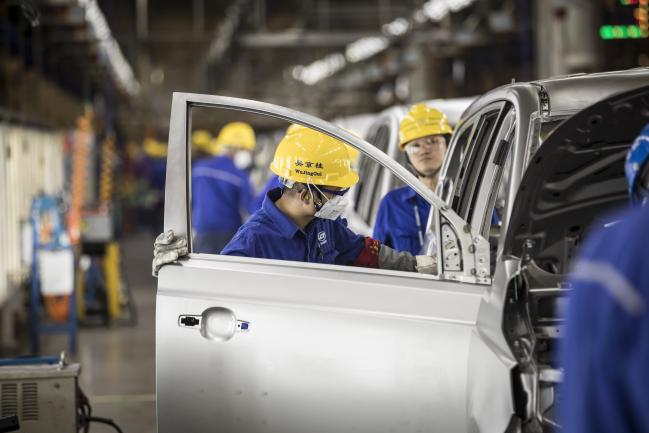(Bloomberg) -- China needs to brace for a “tough economic battle ahead,” in the words of its premier.
It’s a struggle on two main fronts: there’s U.S. President Donald Trump and his demands to cut away support for state firms or face lingering tariffs, while at home there’s the tussle to help struggling private firms without ramping up debt to even more unsustainable levels.
The plan to navigate those challenges was laid out Tuesday in the government’s annual policy report, with Premier Li Keqiang giving himself and President Xi Jinping some wriggle room by lowering the economic growth target for 2019 to a range of 6 to 6.5 percent, down from “about” 6.5 percent last year.
The acceptance of the economy’s inexorable slowdown -- the lower bound of the new target would be the slowest expansion in almost three decades -- was largely cheered by economists who warn anything faster would need excessive stimulus and erode long-term financial stability.
There was another encouraging change too. In days gone by, policymakers would have responded to the confluence of challenges seen now with an all-out spending binge on roads, rail, and whatever else could keep growth humming above 10 percent. Not today. While there’ll still be plenty of highway and fast-train projects, there’s also a push to cut taxes -- a move that gives the private sector more breathing room, even if it’s a slower boost to growth.
In all, Li rolled out tax cuts worth almost 2 trillion yuan ($298 billion) and pledged further stimulus ahead. While that emphasis on stronger fiscal policy can be seen as a loosening from last year’s vow to curb financial risks and trim the budget, the overall goal is still to buffer the economy without letting debt accelerate once more. That’s a balancing act that will be severely tested should any new threats to growth appear.
“It’s a big fiscal push,” said Michael Spencer, global head of economics at Deutsche Bank AG (DE:DBKGn) in Hong Kong. “There’s a reluctance to just turn on the infrastructure tap if they don’t need to.”
Li warned that China faces a graver and more complicated environment this year. He’s trying to rekindle lending to the private sector, mindful that the total debt pile is approaching 300 percent of GDP. “China must be fully prepared for a tough struggle,” he said.
That struggle isn’t only a domestic affair. With Europe’s growth engine sputtering and the longevity of the U.S. expansion under question, a more severe Chinese downturn would be bad news for the global economy and spell trouble for the Asian nations that are integrated into its supply chain.
For now, policy makers are focused on managing the nation’s long deceleration from the double-digit growth rates of the early 2000s. Economists surveyed by Bloomberg see output growth slowing to 6.2 percent this year from 6.6 percent in 2018, before easing further in 2020 and 2021.
A cut of 3 percentage points to the top bracket of value added tax was announced in a move aimed at benefiting the manufacturing sector, a plan reported by Bloomberg News on Monday. In addition, a 1 percentage point cut to the 10 percent VAT bracket was announced. Combined, the VAT cuts are equivalent to as much as 800 billion yuan and will boost corporate earnings, according to Morgan Stanley (NYSE:MS).
The target budget deficit for 2019 was set at 2.8 percent of GDP, versus last year’s goal of 2.6 percent. The report pledged a “noticeable decrease” in the tax burdens of major industries.
Despite the tax cuts, Li’s report pledged to keep China’s leverage ratio “basically stable” in 2019. That may be a difficult feat. The message from the gathering is that shoring up growth is the new normal and that deleveraging is “definitely out,” said Pauline Loong, managing director at research firm Asia-Analytica in Hong Kong.
Indeed, from bank loans to trust-product issuance to margin-trading accounts at stock brokerages, leverage in China is rising nearly everywhere it can. Bank loans jumped by a record amount in January, and off-balance sheet financing rose for the first time in 11 months. The premier himself has warned of a too-rapid increase in short-term funding.
Unlike in previous years, there were no targets for retail sales growth or fixed-asset investment. The reports reiterated that monetary policy will remain “prudent,” while fiscal policy will be “proactive, stronger, and more effective.” Further cuts to the required reserves ratio for smaller banks are planned, Li said.
The U.S. and China are close to a trade deal that could lift most or all U.S. tariffs as long as Beijing follows through on pledges ranging from better protecting intellectual-property rights to buying a significant amount of American products. That would remove one cloud hanging over the economy, leaving Xi with a lesser need to use stimulus to support growth.
"Setting the growth target at 6-6.5 percent range suggests the government does not want to have a large stimulus repeated even with significant uncertainty of external shock arising from the U.S. tariffs," said Liu Ligang, chief China economist at Citigroup Inc (NYSE:C). in Hong Kong.
